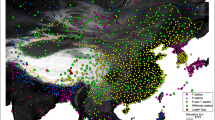Abstract
Climate data in gridded format are critical for understanding climate change and its impact on eco-environment. The aim of the current study is to develop spatial databases for three climate variables (maximum, minimum temperatures, and relative humidity) over a large region with complex topography in southwestern China. Five widely used approaches including inverse distance weighting, ordinary kriging, universal kriging, co-kriging, and thin-plate smoothing spline were tested. Root mean square error (RMSE), mean absolute error (MAE), and mean absolute percentage error (MAPE) showed that thin-plate smoothing spline with latitude, longitude, and elevation outperformed other models. Average RMSE, MAE, and MAPE of the best models were 1.16 °C, 0.74 °C, and 7.38 % for maximum temperature; 0.826 °C, 0.58 °C, and 6.41 % for minimum temperature; and 3.44, 2.28, and 3.21 % for relative humidity, respectively. Spatial datasets of annual and monthly climate variables with 1-km resolution covering the period 1961–2010 were then obtained using the best performance methods. Comparative study showed that the current outcomes were in well agreement with public datasets. Based on the gridded datasets, changes in temperature variables were investigated across the study area. Future study might be needed to capture the uncertainty induced by environmental conditions through remote sensing and knowledge-based methods.





Similar content being viewed by others
References
Antonić O, Križan J, Marki A, Bukovec D (2001) Spatio-temporal interpolation of climatic variables over large region of complex terrain using neural networks. Ecol Model 138:255–263
Chiles JP, Delfiner P (1999) Geostatistics: modeling spatial uncertainty. Wiley, New York
Daly C (2006) Guidelines for assessing the suitability of spatial climate data sets. Int J Climatol 26:707–721
Gassman PW, Reyes M, Green CH, Arnold JG (2007) The soil and water assessment tool: historical development, applications, and future directions. Trans ASABE 50(4):1211–1250
Goovaerts P (2000) Geostatistical approaches for incorporating elevation into the spatial interpolation of rainfall. J Hydrol 228:113–129
Guan BT, Hsu HW, Wey TH, Tsao LS (2009) Modeling monthly mean temperatures for the mountain regions of Taiwan by generalized additive models. Agr Forest Meteorol 149:281–290
Hancock PA, Hutchinson MF (2006) Spatial interpolation of large climate data sets using bivariate thin plate smoothing splines. Environ Model Software 21:1684–1694
Hartkamp AD, De Beurs K, Stein A, White JW (1999) Interpolation techniques for climate variables, NRG-GIS Series 99-01. CIMMYT, Mexico, D.F
Hijmans RJ, Cameron SE, Parra JL, Jones PG, Jarvis A (2005) Very high resolution interpolated climate surfaces for global land areas. Int J Climatol 25:1965–1978
Hofstra N, Haylock M, New M, Jones P, Frei C (2008) Comparison of six methods for the interpolation of daily, European climate data. J Geophys Res 113:D21110–D21119
Hong Y, Nix HA, Hutchinson MF, Booth TH (2005) Spatial interpolation of monthly mean climate data for China. Int J Climatol 25:1369–1379
Hutchinson MF (1991) The application of thin plate smoothing splines to continent-wide data assimilation. In: Jasper J (ed) Data assimilation systems: BMRC research report no. 27. Bureau of Meteorology, Melbourne, pp 104–113
Hutchinson MF (1995) Interpolating mean rainfall using thin plate smoothing splines. Int J Geogr Inf Syst 9:385–403
Hutchinson MF (2001) ANUSPLIN user guide. Australian National University, Canberra
Isaaks EH, Srivastava RM (1989) An introduction to applied geostatistics. Oxford University Press, New York
Jarvis CH, Stuart N (2001) A comparison among strategies for interpolating maximum and minimum daily air temperature. Part I: the selection of “Guiding” topographic and land cover variables. J Appl Meteorol 40:1060–1074
Jeffrey SJ, Carter JO, Moodie KB, Beswick AR (2001) Using spatial interpolation to construct a comprehensive archive of Australian climate data. Environ Model Software 16:309–330
Jones JW, Hoogenboom G, Porter CH, Boote KJ, Batchelor WD, Hunt LA, Wilkens PW, Singh U, Gijsman AJ, Ritchie JT (2003) DSSAT cropping system model. Eur J Agron 18:235–265
National Development and Reform Commission (NDRC) (2007) China’s national climate change programme. http://www.china.org.cn/english/environment/ 213624.htm
Odeh IOA, McBratney AB, Chittleborough DJ (1995) Further results on prediction of soil properties from terrain attributes: heterotopic cokriging and regression-kriging. Geoderma 67:215–225
Price DT, McKenny DW, Nalder IA, Hutchinson MF, Kesteven JL (2000) A comparison of two statistical methods for spatial interpolation of Canadian monthly mean climate data. Agr Forest Meteorol 101:81–94
Tabony RC (1985) Relations between minimum temperature and topography in Great Britain. Int J Climatol 5:503–520
Thornton PE, Running SW, White MA (1997) Generating surfaces of daily meteorological variables over large regions of complex terrain. J Hydrol 190:214–251
Vicente-Serrano SM, Saz-Sanchez MA, Cuadrat JM (2003) Comparative analysis of interpolation methods in the middle Ebro Valley (Spain): application to annual precipitation and temperature. Climate Res 24:161–180
Wu W, Tang XP, Yang C, Guo NJ, Liu HB (2013) Spatial estimation of monthly mean daily sunshine hours and solar radiation across mainland China. Renew Energy 57:546–553
Acknowledgments
This research was funded by Chongqing Key Laboratory of Digital Agriculture, Science & Technology Projects of China National Tobacco Corporation (CNTC) Chongqing companies, Natural Science Foundation Project of CQ CSTC (2010BB1008), Scientific Research Foundation for the Returned Overseas Chinese Scholars (2010-1174).
Author information
Authors and Affiliations
Corresponding author
Rights and permissions
About this article
Cite this article
Wu, W., Xu, AD. & Liu, HB. High-resolution spatial databases of monthly climate variables (1961–2010) over a complex terrain region in southwestern China. Theor Appl Climatol 119, 353–362 (2015). https://doi.org/10.1007/s00704-014-1123-1
Received:
Accepted:
Published:
Issue Date:
DOI: https://doi.org/10.1007/s00704-014-1123-1




